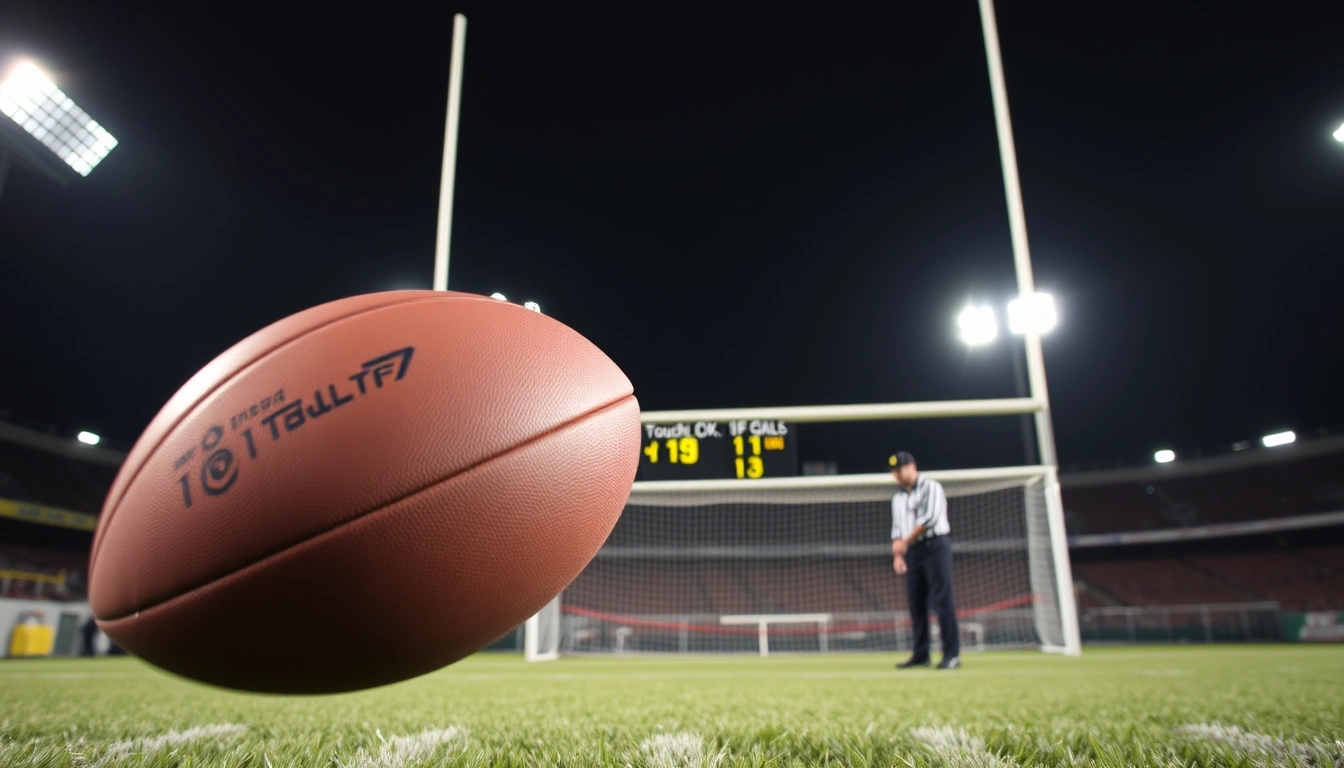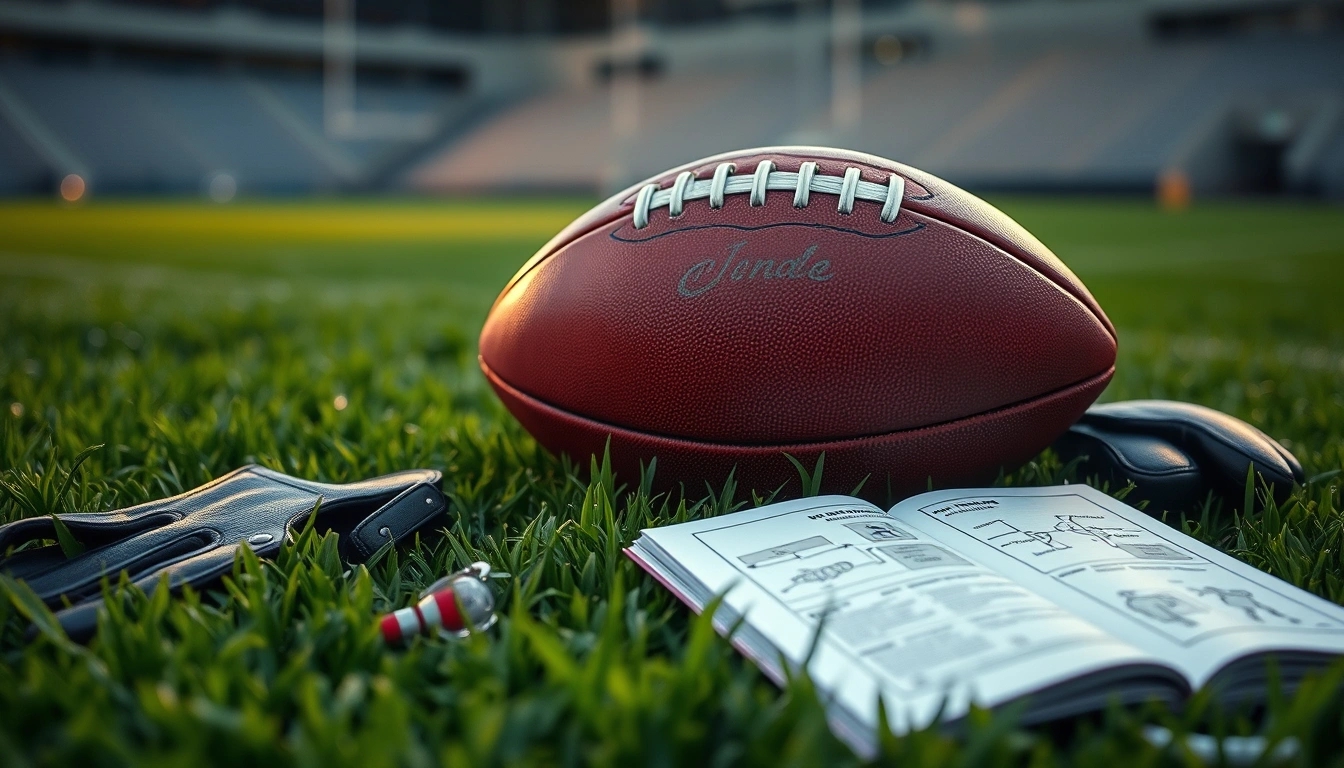Getting into football? Well, buckle up because it’s like stepping into a whole new world where everyone’s speaking a language that sounds like a mix of rocket science and Shakespeare. But don’t sweat it! Here’s a handy guide to help you sound like you’ve been watching games since forever — or at least since last Sunday.
Kickoff and Coin Toss
Alright, first things first: the game doesn’t just start with a whistle; there’s a ritual. The coin toss decides who gets the ball first — heads or tails, simple enough, right? But it’s more than just luck; the winner chooses to either kick or receive the ball, which can totally change the game’s flow. Then comes the kickoff, where one team boots the ball downfield to the other, launching the action.
| Term | What It Means |
|---|---|
| Coin Toss | Pre-game flip deciding possession |
| Kickoff | The starting kick to begin play |
Downs Explained
Now, here’s where newbies usually scratch their heads: downs. Think of downs as chances — the offense gets four tries (or downs) to move the ball 10 yards. If they succeed, boom, they get a fresh set of downs. Fail, and the other team gets the ball. Simple? Sort of. It’s like trying to climb a slippery hill with only four steps.
- 1st Down: The first try to gain yards
- 2nd Down: The second chance, usually a bit riskier
- 3rd Down: The crunch time to make something happen
- 4th Down: The last shot — often a punt or a risky play
Touchdowns and Field Goals
Scoring isn’t just about smashing into the end zone for a touchdown (which nets you 6 points, by the way). Sometimes teams settle for a field goal, kicking the ball through the uprights for 3 points. It’s like the difference between a grand slam and a solid single in baseball — both good, but one’s flashier.
| Score Type | Points | How It Happens |
|---|---|---|
| Touchdown | 6 | Ball carried or caught in the end zone |
| Field Goal | 3 | Kicking ball through goalposts |
Penalties and Flags
Ever noticed those yellow flags flying everywhere? That’s football’s way of saying, “Hey, someone messed up!” Penalties can be confusing, but some common ones like holding, offside, or pass interference can totally flip the game’s momentum. So keep an eye out for those flags — they’re drama in fabric form.
Positions on the Field
From the flashy quarterback calling plays, to the tough-as-nails linebackers smashing through the offense, each position has a unique role. Knowing who does what helps you follow the game better — and impress your friends.
- Quarterback (QB): The team’s play-caller and usually the star
- Running Back (RB): The guy who runs with the ball
- Wide Receiver (WR): The fast player catching passes
- Linebacker (LB): Defensive player stopping the offense
Offense vs. Defense
Football’s basically a tug-of-war between offense and defense. The offense tries to score; the defense tries to stop them. Think of it like a chess match, but with more sweat and less quiet.
Special Teams
Don’t ignore the special teams — they handle kickoffs, punts, and those wild trick plays that can turn the tide in seconds. They might not get the glory, but they’re crucial.
Game Clock and Overtime
Time’s ticking, and managing the game clock is a game within the game. If the score’s tied at the end, welcome to overtime — sudden death or extra time that’ll have you biting your nails.
Common Jargon and Slang
Finally, football’s got its own slang — stuff like “Hail Mary,” “Blitz,” or “Pick Six.” Learning these makes you sound like a pro, or at least less like a confused tourist.
So there you have it! Dive in, don’t be afraid to ask questions, and remember: even the biggest fans were newbies once.
Kickoff and Coin Toss
Kickoff and Coin Toss: the very first moments of a football game, and boy, do they pack a punch! If you’re new to football, these two might seem like mere formalities, but trust me, they set the entire tone for what’s about to unfold on that gridiron battlefield. Let’s break it down without the snooze fest.
First off, the coin toss. It’s that classic heads-or-tails moment right before kickoff. The referee flips a coin, and the team captains gather ’round, eyes locked in suspense. The winner of the toss gets to pick whether they want to kickoff or receive the ball first, or sometimes even choose which goal to defend. Sounds simple, but it’s a strategic goldmine. Why? Because starting with the ball can be a huge advantage, giving your offense a chance to set the pace. Or, if the weather’s nasty, picking the side with the wind at your back can help your kicking game. It’s not just luck; it’s chess, not checkers.
- Heads or tails? The coin toss is the opening gambit.
- Winning the toss: Pick kickoff, receive, or field side.
- Strategic decisions: Weather, momentum, and game plan all come into play.
Now, on to the actual kickoff. This is where the game officially kicks off—literally. The kicking team lines up on their 35-yard line (in the NFL), and the ball is sent soaring downfield to the receiving team. The receiving team’s job? Catch it, dodge defenders, and try to run it back as far as possible. Sometimes, you’ll see a “touchback” — if the ball goes into the end zone and the returner kneels, the play stops, and the offense starts at the 25-yard line. Not the most exciting, but it’s a safe move.
| Kickoff Key Points | Details |
|---|---|
| Kickoff spot | 35-yard line (NFL standard) |
| Touchback | Ball lands in end zone, no return, offense starts at 25-yard line |
| Return | Receiving team tries to run the ball back for yards or a touchdown |
| Onside kick | A sneaky short kick to try and regain possession |
Speaking of sneaky, the onside kick is a wild card here. It’s like the football equivalent of a Hail Mary pass. The kicking team tries to surprise the receiving team with a short, bouncing kick that they hope to recover themselves. It’s risky, often messy, and sometimes downright chaotic — but when it works, oh man, the crowd goes nuts.
So, why does all this matter? Because kickoff and coin toss aren’t just ceremonial fluff. They’re the opening moves in a strategic tug-of-war. Winning the toss can mean setting the tempo, and a solid kickoff return can flip momentum quicker than you can say “touchdown.” Plus, those early moments get everyone hyped — players, fans, and even the folks watching from their couch.
In short, don’t just tune out during the coin toss and kickoff. These moments are football’s curtain-raiser, the spark that lights the fire. Understanding them means you’re already one step closer to speaking football fluently — and trust me, that’s half the fun of the game.
Downs Explained
If you’re new to football, the whole concept of “downs” can feel like trying to crack a secret code. Seriously, it’s one of those things that trips up even some casual fans. But don’t sweat it — once you get the hang of it, downs become the heartbeat of the game, dictating how teams move, strategize, and sometimes, just plain struggle. So, let’s break it down nice and easy.
First off, what exactly is a down? Think of a down as a single play or attempt by the offense to move the ball forward. The team on offense gets four downs (or tries) to advance the ball at least 10 yards. If they manage to move those 10 yards within those four tries, they earn a new set of four downs — basically a fresh start. If not? Well, the other team gets the ball, and the offense’s turn is over.
| Down Number | What Happens |
|---|---|
| 1st Down | Starting point of the series; offense tries to gain yards. |
| 2nd Down | Second attempt; usually a chance to adjust strategy. |
| 3rd Down | Crucial play; often a “make or break” moment to keep the drive alive. |
| 4th Down | Last chance; teams often punt or attempt a field goal unless they’re feeling risky. |
Now, here’s where it gets a bit tricky — not every play gains yards. Sometimes the offense loses ground, or the defense makes a big stop. That’s why the downs system is so important: it forces the offense to keep pushing forward, or else hand the ball over. It’s like a ticking clock but with plays instead of seconds.
- Why do downs matter? Because they create tension. Every play counts. Coaches are constantly calculating whether to play it safe or gamble on a 4th down conversion.
- What happens on 4th down? Usually, teams punt to avoid giving the other team good field position. But sometimes, they go for it, which can lead to some jaw-dropping moments — or facepalm-worthy fails.
To put it simply: downs are the game’s way of saying, “Keep moving forward, or you’re done.” It’s a built-in pressure cooker that makes football exciting and unpredictable.
Example:1st Down & 10 yards to go: The offense tries to gain yards.If they gain 5 yards, next is 2nd Down & 5 yards to go.If on 3rd Down they gain the remaining 5 yards, it resets to 1st Down & 10 yards.Fail to gain 10 yards by 4th Down? Turnover on downs.
So, next time you’re watching a game and hear the announcer say “3rd and 7,” you’ll know they mean it’s the third try to cover 7 yards. Nail that, and the offense gets a fresh set of downs. Miss it, and the defense might just get the ball.
In a nutshell, downs are the rhythm of football — the push and pull that keeps the game moving. Once you’re comfortable with this, you’ll catch yourself nodding along and maybe even shouting at the TV, “Go for it on 4th down!” Just don’t blame me if it doesn’t work out every time.

Touchdowns and Field Goals
Alright, so you’ve probably heard the term touchdown thrown around a million times, right? It’s basically the big kahuna of scoring in football. When a player carries the ball across the opponent’s goal line or catches it in the end zone, boom—that’s a touchdown, worth a whopping six points. Sounds simple enough, but there’s a bit more to it than just running or catching. Sometimes, it’s a wild scramble, other times a perfectly executed pass, but either way, the crowd goes nuts.
Now, here’s the kicker (pun totally intended): scoring isn’t just about touchdowns. Enter the field goal. This little gem is what happens when a team can’t quite punch it into the end zone but is close enough to attempt a kick through those tall uprights. If that ball sails right through, the team bags three points. Not as flashy as a touchdown, but hey, every point counts, especially in those nail-biter games.
| Scoring Type | Points Awarded | How It Happens | Typical Situation |
|---|---|---|---|
| Touchdown | 6 | Run or catch ball in end zone | Offense breaks through defense |
| Field Goal | 3 | Kicking ball through goalposts | Close but no touchdown |
After scoring a touchdown, there’s this quirky little moment called the extra point or two-point conversion. Most teams go for the easy extra point—a kick from the 15-yard line that’s almost automatic. But sometimes, if they’re feeling spicy or desperate, they’ll try to run or pass the ball into the end zone again for two extra points. Risky move, but it can pay off big.
- Touchdown: 6 points + opportunity for extra point(s)
- Field Goal: 3 points, no extra attempts
- Safety: Worth mentioning here too—2 points for defense if they tackle offense in their own end zone
Honestly, field goals often get a bad rap. Fans love touchdowns because they’re flashy and exciting, but field goals? They’re the steady, reliable cousin that sneaks in points when the offense hits a wall. Some games are literally won or lost on clutch field goals—so don’t underestimate the power of a kicker with nerves of steel.
And here’s a fun fact: the kicker’s job is one of the most high-pressure gigs in football. Imagine standing there, all eyes on you, with seconds ticking down and the game on the line. Miss it, and you’re the villain. Nail it, and you’re a hero. Talk about living on the edge!
To put it simply, touchdowns and field goals are the yin and yang of football scoring. One’s about brute force and strategy, the other about precision and nerves. Together, they keep the scoreboard ticking and fans biting their nails. So next time you’re watching a game, don’t just cheer for the touchdowns—give a little love to those field goals too. They’re the unsung heroes of the gridiron.
Penalties and Flags
So, you’re watching a football game, and suddenly, yellow flags start flying everywhere like confetti at a parade. It’s confusing, right? One moment the offense is charging ahead, the next—wham!—a flag is thrown, and the momentum screeches to a halt. Penalties in football aren’t just minor hiccups; they can completely flip the script of a game. If you want to keep up with the drama and avoid looking like a deer caught in the headlights, understanding the most common fouls is a must.
First off, let’s get one thing straight: a penalty means someone broke the rules, plain and simple. The referees throw a yellow flag to signal that. Sometimes it’s a 5-yard penalty, sometimes 15, and occasionally, it’s a whole lot worse. And just when you think you’ve got it down, there’s a red flag too—coaches can throw it to challenge a call, adding another layer to the chaos.
| Penalty | Description | Yardage | Impact |
|---|---|---|---|
| False Start | Offensive player moves before the snap | 5 yards | Sets offense back, kills momentum |
| Holding | Illegally grabbing an opponent | 10 yards | Can negate big plays |
| Pass Interference | Illegal contact before the ball arrives | Spot foul (varies) | Gives offense big yardage |
| Offside | Defensive player crosses line early | 5 yards | Free yardage for offense |
| Personal Foul | Rough or unsportsmanlike conduct | 15 yards | Can swing game momentum |
Now, you might be wondering, “How do these penalties actually affect the game?” Well, picture this: your team is driving down the field, the crowd is roaring, and suddenly, a holding call wipes out a 30-yard gain. Talk about a mood killer! Penalties can stall drives, push teams out of scoring range, or even gift the other side a fresh set of downs. It’s like the game’s way of saying, “Not so fast, cowboy.”
Also, some fouls are more sneaky than others. For example, pass interference can be super controversial because it’s often about judgment calls by refs. One minute, a defender’s just doing his job; the next, he’s flagged for grabbing the receiver. Fans and players alike love to debate these calls endlessly—welcome to football’s never-ending soap opera.
- Why do refs throw flags? To keep the game fair and safe, but also to control the chaos.
- Can penalties be declined? Absolutely. Sometimes the team benefits more by ignoring the penalty.
- What about multiple flags? When multiple fouls happen, the refs sort it out, but it can get messy fast.
In short, penalties add a layer of unpredictability to football. They keep players on their toes and fans glued to their seats, biting nails or shouting at the TV. Next time you see those yellow flags flying, don’t just groan—try to spot what went wrong. You’ll start appreciating the game’s complexity, and hey, you might even impress the folks around you with your newfound knowledge. Just remember, in football, it’s not just about the touchdowns and tackles; sometimes, the real story is in the that shape the game’s wild ride.
Positions on the Field
Alright, if you’re just diving into football, the sheer number of positions can feel like a wild maze. From the flashy quarterback to the gritty linebackers, each player has a job that’s crucial to the game’s flow. Honestly, it’s like a big, chaotic orchestra where every instrument matters—even if you don’t always hear them all clearly. So, let’s break down who’s who and what they actually *do* on that grassy battlefield.
The Quarterback (QB) – The undisputed star, or at least the one who gets the most spotlight. The QB is the team’s field general, calling plays, throwing passes, and sometimes running the ball themselves. Without a good QB, a team’s offense can look like a headless chicken. They’re the ones everyone watches, hoping for that perfect throw or a jaw-dropping scramble.
Running Backs (RB) – These guys are the ground troops, charging through the defense trying to rack up yards on the ground. They’re fast, elusive, and tough as nails. You’ll see them dodging tackles, breaking through gaps, or catching short passes. Think of them as the “get it done” players who grind out those crucial yards.
| Position | Primary Role | Key Skills |
|---|---|---|
| Wide Receiver (WR) | Catches passes from the QB | Speed, agility, good hands |
| Linebacker (LB) | Defends against run and pass plays | Tackling, reading offense, strength |
| Defensive End (DE) | Rushes the QB, stops runs | Power, speed, technique |
Now, the defense is a whole different beast. Linebackers are like the Swiss Army knives on defense. They have to be quick enough to cover receivers but strong enough to stop a charging running back. It’s a tough gig. Then you’ve got the Defensive Ends, those guys who live to sack the QB or stuff runs before they get going. They’re the nightmare of offensive linemen everywhere.
- Offensive Linemen – The unsung heroes who protect the QB and open holes for the RB. Without them, the offense is toast.
- Cornerbacks (CB) – They shadow the receivers, trying to prevent catches. Think of them as the defense’s shadow ninjas.
- Safeties – The last line of defense, covering deep passes and stepping up to stop big runs.
Honestly, the positions might seem like alphabet soup at first, but once you start noticing what each player *actually* does, the game clicks into place. Next time you watch a game, try picking out these roles. You might even impress your friends with your newfound “football IQ.” And hey, if you get a little confused, don’t sweat it—football’s complexity is part of the charm.
Position | Role | Key Trait------------------|-----------------------|-----------------Quarterback (QB) | Lead the offense | Decision-making & passingRunning Back (RB) | Run the ball | Speed & powerWide Receiver (WR)| Catch passes | Agility & handsLinebacker (LB) | Defend run & pass | Tackling & versatilityDefensive End (DE)| Pressure QB & run stop| Strength & speed
So yeah, every player’s got their turf, their battle to fight. And together? They make football the unpredictable, edge-of-your-seat spectacle that millions can’t get enough of. Now, who’s ready to call the next game like a pro?

Offense vs. Defense
Football is basically a never-ending tug of war between two squads: the offense and the defense. Sounds simple, right? Well, not exactly. Each side has its own mission, its own strategy, and its own set of frustrations. The offense’s job is to put points on the board, while the defense is hell-bent on stopping them dead in their tracks. Let’s break down what makes this clash so endlessly fascinating.
The Offense: The Point-Scoring Machine
The offense is like the team’s engine, revving up every time they get the ball. Their primary goal? Move the ball down the field and score touchdowns or field goals. They have a playbook thicker than a phone book, full of trick plays, runs, passes, and audibles that keep the defense guessing. The quarterback is the star here, calling the shots and distributing the ball, but don’t overlook the running backs, wide receivers, and the offensive line who all have key roles.
- Quarterback (QB): The chief decision-maker, throwing passes or handing off the ball.
- Running Back (RB): Charges forward, trying to gain yards on the ground.
- Wide Receiver (WR): Runs routes to catch passes, hoping to break free for big gains.
- Offensive Line: The unsung heroes blocking defenders to protect the QB and open lanes.
The Defense: The Relentless Wall
Defense is a whole different beast. Their goal? Prevent the offense from scoring, by any means necessary. They want to force turnovers, sacks, or at least make the offense settle for a field goal instead of a touchdown. Defensive players are like bloodhounds sniffing out the ball, trying to read the offense’s moves and react quickly.
| Defensive Position | Role |
|---|---|
| Defensive Linemen | Crash the offensive line, try to sack the QB or stop running plays. |
| Linebackers | Versatile players who defend against both run and pass. |
| Defensive Backs (Cornerbacks & Safeties) | Cover receivers, defend passes, and make interceptions. |
Why This Battle is So Addictive
Honestly, the offense-defense duel is what makes football thrilling. The offense wants to move fast, keep the defense guessing, and score big. Meanwhile, the defense thrives on chaos, disruption, and forcing mistakes. Sometimes it’s a chess match, other times it’s a brute force brawl. And the momentum swings? Oh boy, one big defensive stop can flip the entire game.
Think about it like this: offense is the artist, trying to paint a masterpiece with yardage and points. Defense is the critic, constantly trying to smudge that masterpiece or stop it altogether. No matter which side you root for, this eternal battle keeps every football fan on the edge of their seat.
Quick Recap:
- Offense: Score points, control the ball, execute plays.
- Defense: Stop scoring, force turnovers, disrupt plays.
- Both: Constantly adapt, outsmart, and outmuscle each other.
So next time you’re watching a game, remember the offense and defense aren’t just teams—they’re two sides of the same coin, locked in a never-ending battle that defines the heart and soul of football.
Special Teams
Alright, let’s talk about . Now, if you’re new to football, you might think these guys are just warming the bench or doing some boring sideline stuff. Nope, not even close! Special teams are like the secret ninjas of the gridiron, stepping in for those crucial moments that can flip the entire game on its head. They handle kickoffs, punts, field goals, and those sneaky trick plays that make you go, “Wait, what just happened?”
Imagine this: the offense just scored, and the other team’s about to kick off. That kickoff team? They’re sprinting downfield, aiming to stop the returner from breaking loose. Sometimes it’s a straightforward tackle, other times it’s a wild, chaotic chase that ends with a huge return touchdown. Momentum swings here, folks. It’s not just a casual jog, it’s a full-on battle for field position.
| Role | Primary Responsibility | Why It Matters |
|---|---|---|
| Kicker | Handles kickoffs and field goals | Scores points and controls field position |
| Punter | Kicks the ball away on fourth down | Pushes opponent back, making offense’s life harder |
| Returner | Returns kickoffs and punts | Can create big plays and momentum swings |
| Coverage Team | Tackles returners and blocks returns | Prevents big yardage gains |
Now, punts are another beast. When a team’s stuck on fourth down and too far to score, they punt. The punter boots the ball high and far, hoping to pin the other team deep in their territory. Meanwhile, the coverage team races downfield, trying to stop the returner from breaking free. It’s a high-speed, high-stakes chase that can either set the defense up nicely or give the offense a short field to work with.
- Fake punts: Sometimes, the punter or the special teams unit tries to trick the other team by running or passing instead of kicking. Risky but can pay off big time.
- Onside kicks: This is the ultimate gamble. The kicking team tries to recover the ball immediately after kickoff to keep possession. Not for the faint-hearted!
Special teams might not get the glamour of a quarterback’s Hail Mary or a linebacker’s bone-crushing sack, but they’re the unsung heroes. Missed field goals, botched snaps, or a brilliant return can all swing the game’s momentum faster than you can say “touchdown.” Coaches spend hours drilling these units because, honestly, games can be won or lost in these moments.
Practical Tip for Fans:- Watch special teams closely; they reveal a lot about a team’s discipline and preparedness.- Remember, a 50-yard field goal isn’t just luck; it’s skill, pressure, and nerves all rolled into one.- Keep an eye on returners—they’re often the most electric players on the field.
So next time you’re watching a game and the camera switches to the kickoff or punt team, don’t just zone out. That’s where some of the most electrifying, game-changing action happens. Trust me, special teams are far from a sideline show—they’re the momentum makers, the game shakers, and sometimes, the real MVPs you didn’t even know you should be watching.
Game Clock and Overtime
Alright, buckle up because when it comes to football, the game clock isn’t just some boring timer ticking away—it’s the heartbeat of the entire drama. You might think, “It’s just 60 minutes, right?” Well, yeah, but those 60 minutes are chopped into four quarters of 15 minutes each, and understanding how that clock works can make or break your grasp of the game’s tension.
First off, the clock doesn’t always run like your microwave timer. It stops and starts on a whim—after incomplete passes, when players go out of bounds, or during penalties. This stop-and-go action means the actual game time can stretch well beyond the 60 minutes. Ever noticed how the last two minutes of the game feel like they last forever? That’s no accident. Coaches and players know exactly when to slow things down or speed them up, and the clock is their best friend—or worst enemy.
| When the Clock Stops | Why It Matters |
|---|---|
| Incomplete Pass | Stops the clock to allow the offense to reset and plan the next play. |
| Player Out of Bounds | Clock stops to prevent time from running out unfairly. |
| Timeouts | Teams can stop the clock to strategize or rest players. |
| Penalties | Clock stops for officials to sort out fouls and enforce rules. |
Now, about that overtime—oh boy, this is where things get downright thrilling and sometimes downright confusing. In the NFL, if the score is tied at the end of regulation, they don’t just call it a day. Instead, they dive into overtime, which is a sudden-death style period but with a twist. The first team to score a touchdown wins immediately, but if the first possession only results in a field goal, the other team gets a chance to respond. It’s like a high-stakes chess match where every move counts.
- Overtime Length: 10 minutes (regular season), 15 minutes (playoffs)
- Sudden Death: First touchdown wins instantly.
- Field Goal Response: Opponent gets a chance to answer if first score is a field goal.
- Multiple Overtime Periods: In playoffs, if still tied, they keep going until someone wins.
Here’s a quick rundown of why time management is a total game-changer: Coaches use the clock to control the pace—sometimes they milk the clock to run out the time, other times they hurry up to squeeze in one last shot. Players have to be aware of how much time they have to make plays, or else it’s like shooting in the dark. And fans? Well, knowing when the clock stops or ticks down adds a whole new layer of excitement. No more staring blankly at the screen wondering why the refs are just standing around.
So, next time you’re watching a nail-biter, keep an eye on that clock. It’s not just a background prop; it’s the silent referee that can flip the game in a heartbeat. And if you ever get confused, just remember: the clock is like that unpredictable friend who sometimes runs late, sometimes rushes, but always keeps you on edge.

Common Jargon and Slang
Football isn’t just a game; it’s a whole language unto itself. If you’re new to the sport, stepping into a stadium or even just watching on TV might feel like you’ve landed in a foreign country where everyone’s chatting in code. But don’t sweat it—once you get the hang of the lingo, you’ll fit right in with the die-hard fans yelling from the stands or debating plays online. Let’s break down some of the most common football slang and jargon that’ll have you sounding like a seasoned fan faster than you can say “touchdown.”
- Blitz: This one’s a fan favorite. When the defense suddenly rushes extra players at the quarterback, it’s called a blitz. It’s like a surprise attack, hoping to sack the QB before he can make a play. It’s intense, chaotic, and often game-changing.
- Hail Mary: No, it’s not a cocktail! A Hail Mary is a desperate, last-ditch long pass thrown toward the end zone, usually when the clock’s ticking down and the team’s behind. Think of it as throwing the ball and praying for a miracle.
- Pick Six: This is a juicy one. When a defensive player intercepts a pass (that’s the “pick”) and runs it back all the way for a touchdown (six points), it’s a pick six. Instant crowd-pleaser and a major momentum swing.
Football jargon doesn’t just stop at plays. You’ll hear terms about players, formations, and even the fans themselves. For example, a “gunner” is a special teams player who races down the field during punts to tackle the returner. And if someone calls a player a “workhorse,” they mean that guy’s carrying the team on his back, grinding out yards play after play.
| Term | Meaning | Why It Matters |
|---|---|---|
| Snap | The start of a play when the center passes the ball to the quarterback | It’s the moment everything kicks off, literally. |
| Red Zone | The area inside the opponent’s 20-yard line | Where scoring chances get real intense. |
| Safety | A 2-point score by the defense when they tackle an offensive player in their own end zone | Rare but a huge momentum shifter. |
And then there’s the colorful slang that fans and commentators toss around like candy. Words like “clutch,” meaning a player who performs well under pressure, or “snaps,” referring to plays or moments in the game. Sometimes the jargon gets downright weird—ever heard of a “flea flicker”? It’s a trick play where the ball is tossed backward before being launched forward, designed to fool the defense. Sounds like something out of a cartoon, but it’s real and can be spectacular.
- “Bomb”: A long pass downfield.
- “Sack”: Tackling the quarterback behind the line of scrimmage.
- “Audible”: When the quarterback changes the play at the line of scrimmage.
Pro tip: Don’t get overwhelmed trying to learn all of these at once. Pick a few terms each game and try to spot them in action. Before you know it, you’ll be dropping football slang like a pro, and the game will feel way less like a confusing mess and way more like a thrilling, understandable sport.
So, next time you’re watching a game and hear someone yell, “He’s gonna blitz!” or “That was a clutch catch!” you’ll know exactly what’s going on—and maybe even impress your friends with your newfound football fluency. Now, go on, get out there and talk the talk!
Frequently Asked Questions
- What exactly is a “down” in football?
Think of a down as a play or a chance for the offense to move the ball forward. You get four downs to advance at least 10 yards. If you succeed, the downs reset—kind of like getting a fresh start on a tricky puzzle. If not, the other team gets the ball. Simple, right?
- How does the coin toss impact the game?
The coin toss is more than just a formality—it decides which team kicks off and who gets the first possession. Winning the toss can give a strategic edge, like choosing to start on offense or defense. It’s the game’s opening gambit that sets the tone!
- Why do I see so many flags on the field?
Those yellow flags? They’re penalties flying around! Penalties happen when players break the rules, and they can shift momentum faster than a lightning strike. Understanding common fouls helps you follow the twists and turns in the game’s drama.
- What’s the difference between a touchdown and a field goal?
A touchdown is the ultimate score—crossing into the end zone for 6 points. A field goal, on the other hand, is like a precision strike, kicking the ball through the uprights for 3 points. Both rack up points but in very different ways.
- Who are special teams, and why should I care?
Special teams might seem like the game’s side show, but they handle kickoffs, punts, and surprise plays that can flip the game on its head. They’re the secret weapon that keeps fans on the edge of their seats!
- How do offense and defense really differ?
Offense is like the artist, crafting plays to score points. Defense is the fortress, trying to block those efforts and regain control. Their battle is the heart of every game, a thrilling tug-of-war you won’t want to miss.
- What’s the deal with the game clock and overtime?
The game clock is the ticking clock of suspense, pushing teams to act fast. When time runs out tied, overtime kicks in—a sudden death showdown that can explode into unforgettable moments. It’s where legends are made!
- Can I learn football slang easily?
Absolutely! Football slang is like a secret code that makes you feel part of the tribe. From “Hail Mary” to “blitz,” picking up these terms is a fun way to sound like a seasoned fan and enjoy the game even more.












